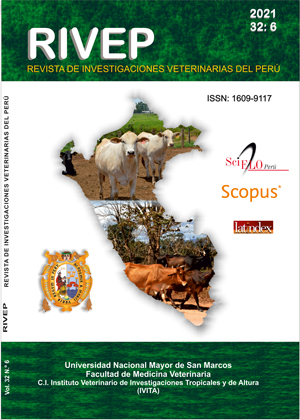Association of gastrointestinal parasitism with physiological parameters in improved sheep of Junín Region, Peru
DOI:
https://doi.org/10.15381/rivep.v32i6.21677Keywords:
FAMACHA, haematocrit, gastrointestinal nematodes, body weight, lambAbstract
The association of gastrointestinal parasitism with body weight, haematocrit and the FAMACHA method was determined in Junín sheep (lambs and rams) from the Stud group of SAIS Túpac Amaru Ltda. No. 1, Junín Region, Peru. The study was carried out in two seasons: May (dry) and October (rainy). In total, 109 rams and 98 lambs were sampled in May and 89 rams and 85 lambs in October 2018. There was a negative correlation between the haematocrit and the transformed value of parasite load. All the animals were positive to gastrointestinal parasites, finding a higher parasite load in males in October and in May in females. In May there were more cases of animals resistant to parasitism than in October. The highest frequency of gastrointestinal parasites was Nematodirus (50%), followed by Trichostrongylus (25%) and Ostertagia (15%).
Downloads
Downloads
Published
Issue
Section
License
Copyright (c) 2021 Fernando Arauco Villar, Ide Unchupaico Payano, Noemí Mayorga Sánchez, Danny Cruz Flores

This work is licensed under a Creative Commons Attribution 4.0 International License.
AUTHORS RETAIN THEIR RIGHTS:
a. Authors retain their trade mark rights and patent, and also on any process or procedure described in the article.
b. Authors retain their right to share, copy, distribute, perform and publicly communicate their article (eg, to place their article in an institutional repository or publish it in a book), with an acknowledgment of its initial publication in the Revista de Investigaciones Veterinarias del Perú (RIVEP).
c. Authors retain theirs right to make a subsequent publication of their work, to use the article or any part thereof (eg a compilation of his papers, lecture notes, thesis, or a book), always indicating the source of publication (the originator of the work, journal, volume, number and date).










